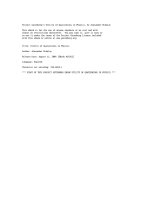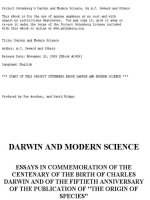Project Gutenberg’s Tractatus Logico-Philosophicus, by Ludwig Wittgenstein pot
Bạn đang xem bản rút gọn của tài liệu. Xem và tải ngay bản đầy đủ của tài liệu tại đây (1.25 MB, 173 trang )
Project Gutenberg’s Tractatus Logico-Philosophicus, by Ludwig Wittgenstein
This eBook is for the use of anyone anywhere at no cost and with
almost no restrictions whatsoever. You may copy it, give it away or
re-use it under the terms of the Project Gutenberg License included
with this eBook or online at www.gutenberg.org
Title: Tractatus Logico-Philosophicus
Author: Ludwig Wittgenstein
Contributor: Bertrand Russell
Translator: C. K. Ogden
Release Date: October 22, 2010 [EBook #5740]
Language: German
Character set encoding: ISO-8859-1
*** START OF THIS PROJECT GUTENBERG EBOOK TRACTATUS LOGICO-PHILOSOPHICUS ***
Produced by Jana Srna, Norbert H. Langkau, and the Online
Distributed Proofreading Team at
TRANSCRIBER’S NOTE
The original publication was a parallel translation; after the introduction,
even pages contained the German original, odd pages the English translation.
This e-book has been reformatted to contain the English translation first and
the German original after that. In the PDF file, the proposition numbers are
linked back and forth between the languages.
The original used a lower-case ‘v’ for the logical or operator; it has been
replaced with the correct ‘∨’ character.
In the German part of the original, variables were printed upright; they
have been italicised in this e-book.
Every effort has been made to replicate the original text as faithfully as
possible. Minor typesetting errors have been corrected; all changes are detailed
in the L
A
T
E
X source code.
International Library of Psychology
Philosophy and Scientific Method
General Editor: C. K. Ogden, m.a.
(Magdalene College, Cambridge)
Tractatus
Logico-Philosophicus
By
LUDWIG WITTGENSTEIN
With an Introduction by
BERTRAND RUSSELL, F.R.S.
LONDON
KEGAN PAUL, TRENCH, TRUBNER & CO., LTD.
NEW YORK: HARCOURT, BRACE & COMPANY, INC.
1922
PRINTED IN GREAT BRITAIN BY THE EDINBURGH PRESS,
9 AND 11 YOUNG STREET, EDINBURGH.
NOTE
In rendering Mr Wittgenstein’s Tractatus Logico-Philosophicus avail-
able for English readers, the somewhat unusual course has been adopted
of printing the original side by side with the translation. Such a method
of presentation seemed desirable both on account of the obvious difficul-
ties raised by the vocabulary and in view of the peculiar literary character
of the whole. As a result, a certain latitude has been possible in passages
to which objection might otherwise be taken as over-literal.
The proofs of the translation and the version of the original which
appeared in the final number of Ostwald’s Annalen der Naturphilosophie
(1921) have been very carefully revised by the author himself; and the
Editor further desires to express his indebtedness to Mr F. P. Ramsey, of
Trinity College, Cambridge, for assistance both with the translation and
in the preparation of the book for the press.
C. K. O.
INTRODUCTION
By BERTRAND RUSSELL
Mr Wittgenstein’s Tractatus Logico-Philosophicus, whether or
not it prove to give the ultimate truth on the matters with which it deals,
certainly deserves, by its breadth and scope and profundity, to be con-
sidered an important event in the philosophical world. Starting from the
principles of Symbolism and the relations which are necessary between
words and things in any language, it applies the result of this inquiry to
various departments of traditional philosophy, showing in each case how
traditional philosophy and traditional solutions arise out of ignorance of
the principles of Symbolism and out of misuse of language.
The logical structure of propositions and the nature of logical in-
ference are first dealt with. Thence we pass successively to Theory of
Knowledge, Principles of Physics, Ethics, and finally the Mystical (das
Mystische).
In order to understand Mr Wittgenstein’s book, it is necessary to re-
alize what is the problem with which he is concerned. In the part of his
theory which deals with Symbolism he is concerned with the conditions
which would have to be fulfilled by a logically perfect language. There are
various problems as regards language. First, there is the problem what
actually occurs in our minds when we use language with the intention
of meaning something by it; this problem belongs to psychology. Sec-
ondly, there is the problem as to what is the relation subsisting between
thoughts, words, or sentences, and that which they refer to or mean; this
problem belongs to epistemology. Thirdly, there is the problem of using
sentences so as to convey truth rather than falsehood; this belongs to
the special sciences dealing with the subject-matter of the sentences in
question. Fourthly, there is the question: what relation must one fact
(such as a sentence) have to another in order to be capable of being a
symbol for that other? This last is a logical question, and is the one with
which Mr Wittgenstein is concerned. He is concerned with the conditions
for accurate Symbolism, i.e. for Symbolism in which a sentence “means”
something quite definite. In practice, language is always more or less
vague, so that what we assert is never quite precise. Thus, logic has two
problems to deal with in regard to Symbolism: (1) the conditions for
sense rather than nonsense in combinations of symbols; (2) the condi-
tions for uniqueness of meaning or reference in symbols or combinations
7
INTRODUCTION
of symbols. A logically perfect language has rules of syntax which pre-
vent nonsense, and has single symbols which always have a definite and
unique meaning. Mr Wittgenstein is concerned with the conditions for a
logically perfect language—not that any language is logically perfect, or
that we believe ourselves capable, here and now, of constructing a logi-
cally perfect language, but that the whole function of language is to have
meaning, and it only fulfils this function in proportion as it approaches
to the ideal language which we postulate.
The essential business of language is to assert or deny facts. Given the
syntax of a language, the meaning of a sentence is determinate as soon
as the meaning of the component words is known. In order that a certain
sentence should assert a certain fact there must, however the language
may be constructed, be something in common between the structure of
the sentence and the structure of the fact. This is perhaps the most
fundamental thesis of Mr Wittgenstein’s theory. That which has to be
in common between the sentence and the fact cannot, so he contends,
be itself in turn said in language. It can, in his phraseology, only be
shown, not said, for whatever we may say will still need to have the same
structure.
The first requisite of an ideal language would be that there should be
one name for every simple, and never the same name for two different
simples. A name is a simple symbol in the sense that it has no parts
which are themselves symbols. In a logically perfect language nothing
that is not simple will have a simple symbol. The symbol for the whole
will be a “complex,” containing the symbols for the parts. In speaking
of a “complex” we are, as will appear later, sinning against the rules
of philosophical grammar, but this is unavoidable at the outset. “Most
propositions and questions that have been written about philosophical
matters are not false but senseless. We cannot, therefore, answer ques-
tions of this kind at all, but only state their senselessness. Most questions
and propositions of the philosophers result from the fact that we do not
understand the logic of our language. They are of the same kind as the
question whether the Good is more or less identical than the Beautiful”
(4.003). What is complex in the world is a fact. Facts which are not
compounded of other facts are what Mr Wittgenstein calls Sachverhalte,
whereas a fact which may consist of two or more facts is called a Tatsa-
che: thus, for example, “Socrates is wise” is a Sachverhalt, as well as a
Tatsache, whereas “Socrates is wise and Plato is his pupil” is a Tatsache
but not a Sachverhalt .
8
INTRODUCTION
He compares linguistic expression to projection in geometry. A geo-
metrical figure may be projected in many ways: each of these ways corre-
sponds to a different language, but the projective properties of the orig-
inal figure remain unchanged whichever of these ways may be adopted.
These projective properties correspond to that which in his theory the
proposition and the fact must have in common, if the proposition is to
assert the fact.
In certain elementary ways this is, of course, obvious. It is impossible,
for example, to make a statement about two men (assuming for the mo-
ment that the men may be treated as simples), without employing two
names, and if you are going to assert a relation between the two men it
will be necessary that the sentence in which you make the assertion shall
establish a relation between the two names. If we say “Plato loves Soc-
rates,” the word “loves” which occurs between the word “Plato” and the
word “Socrates” establishes a certain relation between these two words,
and it is owing to this fact that our sentence is able to assert a relation
between the person’s name by the words “Plato” and “Socrates.” “We
must not say, the complex sign ‘aRb’ says ‘a stands in a certain relation
R to b’; but we must say, that ‘a’ stands in a certain relation to ‘b’ says
that aRb” (3.1432).
Mr Wittgenstein begins his theory of Symbolism with the statement
(2.1): “We make to ourselves pictures of facts.” A picture, he says, is
a model of the reality, and to the objects in the reality correspond the
elements of the picture: the picture itself is a fact. The fact that things
have a certain relation to each other is represented by the fact that in
the picture its elements have a certain relation to one another. “In the
picture and the pictured there must be something identical in order that
the one can be a picture of the other at all. What the picture must
have in common with reality in order to be able to represent it after its
manner—rightly or falsely—is its form of representation” (2.161, 2.17).
We speak of a logical picture of a reality when we wish to imply only
so much resemblance as is essential to its being a picture in any sense,
that is to say, when we wish to imply no more than identity of logical
form. The logical picture of a fact, he says, is a Gedanke. A picture
can correspond or not correspond with the fact and be accordingly true
or false, but in both cases it shares the logical form with the fact. The
sense in which he speaks of pictures is illustrated by his statement: “The
gramophone record, the musical thought, the score, the waves of sound,
all stand to one another in that pictorial internal relation which holds
9
INTRODUCTION
between language and the world. To all of them the logical structure is
common. (Like the two youths, their two horses and their lilies in the
story. They are all in a certain sense one)” (4.014). The possibility of a
proposition representing a fact rests upon the fact that in it objects are
represented by signs. The so-called logical “constants” are not represented
by signs, but are themselves present in the proposition as in the fact. The
proposition and the fact must exhibit the same logical “manifold,” and
this cannot be itself represented since it has to be in common between
the fact and the picture. Mr Wittgenstein maintains that everything
properly philosophical belongs to what can only be shown, to what is
in common between a fact and its logical picture. It results from this
view that nothing correct can be said in philosophy. Every philosophical
proposition is bad grammar, and the best that we can hope to achieve
by philosophical discussion is to lead people to see that philosophical
discussion is a mistake. “Philosophy is not one of the natural sciences.
(The word ‘philosophy’ must mean something which stands above or
below, but not beside the natural sciences.) The object of philosophy is
the logical clarification of thoughts. Philosophy is not a theory but an
activity. A philosophical work consists essentially of elucidations. The
result of philosophy is not a number of ‘philosophical propositions,’ but
to make propositions clear. Philosophy should make clear and delimit
sharply the thoughts which otherwise are, as it were, opaque and blurred”
(4.111 and 4.112). In accordance with this principle the things that have
to be said in leading the reader to understand Mr Wittgenstein’s theory
are all of them things which that theory itself condemns as meaningless.
With this proviso we will endeavour to convey the picture of the world
which seems to underlie his system.
The world consists of facts: facts cannot strictly speaking be defined,
but we can explain what we mean by saying that facts are what make
propositions true, or false. Facts may contain parts which are facts or
may contain no such parts; for example: “Socrates was a wise Athe-
nian,” consists of the two facts, “Socrates was wise,” and “Socrates was
an Athenian.” A fact which has no parts that are facts is called by
Mr Wittgenstein a Sachverhalt. This is the same thing that he calls an
atomic fact. An atomic fact, although it contains no parts that are facts,
nevertheless does contain parts. If we may regard “Socrates is wise” as
an atomic fact we perceive that it contains the constituents “Socrates”
and “wise.” If an atomic fact is analysed as fully as possible (theoret-
ical, not practical possibility is meant) the constituents finally reached
10
INTRODUCTION
may be called “simples” or “objects.” It is not contended by Wittgenstein
that we can actually isolate the simple or have empirical knowledge of
it. It is a logical necessity demanded by theory, like an electron. His
ground for maintaining that there must be simples is that every complex
presupposes a fact. It is not necessarily assumed that the complexity of
facts is finite; even if every fact consisted of an infinite number of atomic
facts and if every atomic fact consisted of an infinite number of objects
there would still be objects and atomic facts (4.2211). The assertion that
there is a certain complex reduces to the assertion that its constituents
are related in a certain way, which is the assertion of a fact: thus if
we give a name to the complex the name only has meaning in virtue
of the truth of a certain proposition, namely the proposition asserting
the relatedness of the constituents of the complex. Thus the naming of
complexes presupposes propositions, while propositions presupposes the
naming of simples. In this way the naming of simples is shown to be
what is logically first in logic.
The world is fully described if all atomic facts are known, together
with the fact that these are all of them. The world is not described
by merely naming all the objects in it; it is necessary also to know the
atomic facts of which these objects are constituents. Given this total of
atomic facts, every true proposition, however complex, can theoretically
be inferred. A proposition (true or false) asserting an atomic fact is called
an atomic proposition. All atomic propositions are logically independent
of each other. No atomic proposition implies any other or is inconsistent
with any other. Thus the whole business of logical inference is concerned
with propositions which are not atomic. Such propositions may be called
molecular.
Wittgenstein’s theory of molecular propositions turns upon his theory
of the construction of truth-functions.
A truth-function of a proposition p is a proposition containing p and
such that its truth or falsehood depends only upon the truth or falsehood
of p, and similarly a truth-function of several propositions p, q, r. . . is
one containing p, q, r. . . and such that its truth or falsehood depends
only upon the truth or falsehood of p, q, r. . . It might seem at first
sight as though there were other functions of propositions besides truth-
functions; such, for example, would be “A believes p,” for in general A
will believe some true propositions and some false ones: unless he is an
exceptionally gifted individual, we cannot infer that p is true from the fact
that he believes it or that p is false from the fact that he does not believe
11
INTRODUCTION
it. Other apparent exceptions would be such as “p is a very complex
proposition” or “p is a proposition about Socrates.” Mr Wittgenstein
maintains, however, for reasons which will appear presently, that such
exceptions are only apparent, and that every function of a proposition is
really a truth-function. It follows that if we can define truth-functions
generally, we can obtain a general definition of all propositions in terms
of the original set of atomic propositions. This Wittgenstein proceeds to
do.
It has been shown by Dr Sheffer (Trans. Am. Math. Soc., Vol. XIV.
pp. 481–488) that all truth-functions of a given set of propositions can be
constructed out of either of the two functions “not-p or not-q” or “not-p
and not-q.” Wittgenstein makes use of the latter, assuming a knowledge
of Dr Sheffer’s work. The manner in which other truth-functions are
constructed out of “not-p and not-q” is easy to see. “Not-p and not-p” is
equivalent to “not-p,” hence we obtain a definition of negation in terms
of our primitive function: hence we can define “p or q,” since this is
the negation of “not-p and not-q,” i.e. of our primitive function. The
development of other truth-functions out of “not-p” and “p or q” is given
in detail at the beginning of Principia Mathematica. This gives all that is
wanted when the propositions which are arguments to our truth-function
are given by enumeration. Wittgenstein, however, by a very interesting
analysis succeeds in extending the process to general propositions, i.e. to
cases where the propositions which are arguments to our truth-function
are not given by enumeration but are given as all those satisfying some
condition. For example, let fx be a propositional function (i.e. a function
whose values are propositions), such as “x is human”—then the various
values of f x form a set of propositions. We may extend the idea “not-p
and not-q” so as to apply to simultaneous denial of all the propositions
which are values of fx. In this way we arrive at the proposition which
is ordinarily represented in mathematical logic by the words “fx is false
for all values of x.” The negation of this would be the proposition “there
is at least one x for which fx is true” which is represented by “(∃x) .fx.”
If we had started with not-fx instead of f x we should have arrived at
the proposition “fx is true for all values of x” which is represented by
“(x).fx.” Wittgenstein’s method of dealing with general propositions [i.e.
“(x) . fx” and “(∃x) . fx”] differs from previous methods by the fact that
the generality comes only in specifying the set of propositions concerned,
and when this has been done the building up of truth-functions proceeds
exactly as it would in the case of a finite number of enumerated arguments
p, q, r . . . .
12
INTRODUCTION
Mr Wittgenstein’s explanation of his symbolism at this point is not
quite fully given in the text. The symbol he uses is (p, ξ, N(ξ)). The
following is the explanation of this symbol:
p stands for all atomic propositions.
ξ stands for any set of propositions.
N(ξ) stands for the negation of all the proposi-
tions making up ξ.
The whole symbol (p, ξ, N(ξ)) means whatever can be obtained by
taking any selection of atomic propositions, negating them all, then tak-
ing any selection of the set of propositions now obtained, together with
any of the originals—and so on indefinitely. This is, he says, the general
truth-function and also the general form of proposition. What is meant
is somewhat less complicated than it sounds. The symbol is intended to
describe a process by the help of which, given the atomic propositions,
all others can be manufactured. The process depends upon:
(a) Sheffer’s proof that all truth-functions can be obtained out of
simultaneous negation, i.e. out of “not-p and not-q”;
(b) Mr Wittgenstein’s theory of the derivation of general propositions
from conjunctions and disjunctions;
(c) The assertion that a proposition can only occur in another prop-
osition as argument to a truth-function. Given these three foundations,
it follows that all propositions which are not atomic can be derived from
such as are, by a uniform process, and it is this process which is indicated
by Mr Wittgenstein’s symbol.
From this uniform method of construction we arrive at an amazing
simplification of the theory of inference, as well as a definition of the sort
of propositions that belong to logic. The method of generation which has
just been described, enables Wittgenstein to say that all propositions can
be constructed in the above manner from atomic propositions, and in this
way the totality of propositions is defined. (The apparent exceptions
which we mentioned above are dealt with in a manner which we shall
consider later.) Wittgenstein is enabled to assert that propositions are
all that follows from the totality of atomic propositions (together with
the fact that it is the totality of them); that a proposition is always a
truth-function of atomic propositions; and that if p follows from q the
meaning of p is contained in the meaning of q, from which of course it
results that nothing can be deduced from an atomic proposition. All the
13
INTRODUCTION
propositions of logic, he maintains, are tautologies, such, for example, as
“p or not p.”
The fact that nothing can be deduced from an atomic proposition
has interesting applications, for example, to causality. There cannot, in
Wittgenstein’s logic, be any such thing as a causal nexus. “The events
of the future,” he says, “cannot be inferred from those of the present.
Superstition is the belief in the causal nexus.” That the sun will rise
to-morrow is a hypothesis. We do not in fact know whether it will rise,
since there is no compulsion according to which one thing must happen
because another happens.
Let us now take up another subject—that of names. In Wittgenstein’s
theoretical logical language, names are only given to simples. We do
not give two names to one thing, or one name to two things. There
is no way whatever, according to him, by which we can describe the
totality of things that can be named, in other words, the totality of
what there is in the world. In order to be able to do this we should
have to know of some property which must belong to every thing by
a logical necessity. It has been sought to find such a property in self-
identity, but the conception of identity is subjected by Wittgenstein to a
destructive criticism from which there seems no escape. The definition of
identity by means of the identity of indiscernibles is rejected, because the
identity of indiscernibles appears to be not a logically necessary principle.
According to this principle x is identical with y if every property of x is a
property of y, but it would, after all, be logically possible for two things
to have exactly the same properties. If this does not in fact happen
that is an accidental characteristic of the world, not a logically necessary
characteristic, and accidental characteristics of the world must, of course,
not be admitted into the structure of logic. Mr Wittgenstein accordingly
banishes identity and adopts the convention that different letters are to
mean different things. In practice, identity is needed as between a name
and a description or between two descriptions. It is needed for such
propositions as “Socrates is the philosopher who drank the hemlock,” or
“The even prime is the next number after 1.” For such uses of identity it
is easy to provide on Wittgenstein’s system.
The rejection of identity removes one method of speaking of the to-
tality of things, and it will be found that any other method that may be
suggested is equally fallacious: so, at least, Wittgenstein contends and, I
think, rightly. This amounts to saying that “object” is a pseudo-concept.
To say “x is an object” is to say nothing. It follows from this that we
14
INTRODUCTION
cannot make such statements as “there are more than three objects in the
world,” or “there are an infinite number of objects in the world.” Objects
can only be mentioned in connexion with some definite property. We can
say “there are more than three objects which are human,” or “there are
more than three objects which are red,” for in these statements the word
object can be replaced by a variable in the language of logic, the variable
being one which satisfies in the first case the function “x is human”; in
the second the function “x is red.” But when we attempt to say “there
are more than three objects,” this substitution of the variable for the
word “object” becomes impossible, and the proposition is therefore seen
to be meaningless.
We here touch one instance of Wittgenstein’s fundamental thesis,
that it is impossible to say anything about the world as a whole, and
that whatever can be said has to be about bounded portions of the world.
This view may have been originally suggested by notation, and if so, that
is much in its favour, for a good notation has a subtlety and suggestive-
ness which at times make it seem almost like a live teacher. Notational
irregularities are often the first sign of philosophical errors, and a perfect
notation would be a substitute for thought. But although notation may
have first suggested to Mr Wittgenstein the limitation of logic to things
within the world as opposed to the world as a whole, yet the view, once
suggested, is seen to have much else to recommend it. Whether it is
ultimately true I do not, for my part, profess to know. In this Introduc-
tion I am concerned to expound it, not to pronounce upon it. According
to this view we could only say things about the world as a whole if we
could get outside the world, if, that is to say, it ceased to be for us the
whole world. Our world may be bounded for some superior being who
can survey it from above, but for us, however finite it may be, it cannot
have a boundary, since it has nothing outside it. Wittgenstein uses, as
an analogy, the field of vision. Our field of vision does not, for us, have a
visual boundary, just because there is nothing outside it, and in like man-
ner our logical world has no logical boundary because our logic knows of
nothing outside it. These considerations lead him to a somewhat curious
discussion of Solipsism. Logic, he says, fills the world. The boundaries of
the world are also its boundaries. In logic, therefore, we cannot say, there
is this and this in the world, but not that, for to say so would apparently
presuppose that we exclude certain possibilities, and this cannot be the
case, since it would require that logic should go beyond the boundaries of
the world as if it could contemplate these boundaries from the other side
15
INTRODUCTION
also. What we cannot think we cannot think, therefore we also cannot
say what we cannot think.
This, he says, gives the key to Solipsism. What Solipsism intends is
quite correct, but this cannot be said, it can only be shown. That the
world is my world appears in the fact that the boundaries of language
(the only language I understand) indicate the boundaries of my world.
The metaphysical subject does not belong to the world but is a boundary
of the world.
We must take up next the question of molecular propositions which
are at first sight not truth-functions, of the propositions that they con-
tain, such, for example, as “A believes p.”
Wittgenstein introduces this subject in the statement of his position,
namely, that all molecular functions are truth-functions. He says (5.54):
“In the general propositional form, propositions occur in a proposition
only as bases of truth-operations.” At first sight, he goes on to explain,
it seems as if a proposition could also occur in other ways, e.g. “A believes
p.” Here it seems superficially as if the proposition p stood in a sort of
relation to the object A. “But it is clear that ‘A believes that p,’ ‘A
thinks p,’ ‘A says p’ are of the form ‘p says p’; and here we have no co-
ordination of a fact and an object, but a co-ordination of facts by means
of a co-ordination of their objects” (5.542).
What Mr Wittgenstein says here is said so shortly that its point is
not likely to be clear to those who have not in mind the controversies
with which he is concerned. The theory with which he is disagreeing
will be found in my articles on the nature of truth and falsehood in
Philosophical Essays and Proceedings of the Aristotelian Society, 1906–
7. The problem at issue is the problem of the logical form of belief,
i.e. what is the schema representing what occurs when a man believes.
Of course, the problem applies not only to belief, but also to a host of
other mental phenomena which may be called propositional attitudes:
doubting, considering, desiring, etc. In all these cases it seems natural
to express the phenomenon in the form “A doubts p,” “A desires p,” etc.,
which makes it appear as though we were dealing with a relation between
a person and a proposition. This cannot, of course, be the ultimate
analysis, since persons are fictions and so are propositions, except in
the sense in which they are facts on their own account. A proposition,
considered as a fact on its own account, may be a set of words which a
man says over to himself, or a complex image, or train of images passing
through his mind, or a set of incipient bodily movements. It may be
16
INTRODUCTION
any one of innumerable different things. The proposition as a fact on its
own account, for example the actual set of words the man pronounces
to himself, is not relevant to logic. What is relevant to logic is that
common element among all these facts, which enables him, as we say, to
mean the fact which the proposition asserts. To psychology, of course,
more is relevant; for a symbol does not mean what it symbolizes in virtue
of a logical relation alone, but in virtue also of a psychological relation of
intention, or association, or what-not. The psychological part of meaning,
however, does not concern the logician. What does concern him in this
problem of belief is the logical schema. It is clear that, when a person
believes a proposition, the person, considered as a metaphysical subject,
does not have to be assumed in order to explain what is happening. What
has to be explained is the relation between the set of words which is the
proposition considered as a fact on its own account, and the “objective”
fact which makes the proposition true or false. This reduces ultimately to
the question of the meaning of propositions, that is to say, the meaning of
propositions is the only non-psychological portion of the problem involved
in the analysis of belief. This problem is simply one of a relation of
two facts, namely, the relation between the series of words used by the
believer and the fact which makes these words true or false. The series of
words is a fact just as much as what makes it true or false is a fact. The
relation between these two facts is not unanalysable, since the meaning
of a proposition results from the meaning of its constituent words. The
meaning of the series of words which is a proposition is a function of the
meanings of the separate words. Accordingly, the proposition as a whole
does not really enter into what has to be explained in explaining the
meaning of a proposition. It would perhaps help to suggest the point of
view which I am trying to indicate, to say that in the cases we have been
considering the proposition occurs as a fact, not as a proposition. Such
a statement, however, must not be taken too literally. The real point
is that in believing, desiring, etc., what is logically fundamental is the
relation of a proposition considered as a fact, to the fact which makes it
true or false, and that this relation of two facts is reducible to a relation
of their constituents. Thus the proposition does not occur at all in the
same sense in which it occurs in a truth-function.
There are some respects, in which, as it seems to me, Mr Wittgen-
stein’s theory stands in need of greater technical development. This ap-
plies in particular to his theory of number (6.02 ff.) which, as it stands, is
only capable of dealing with finite numbers. No logic can be considered
17
INTRODUCTION
adequate until it has been shown to be capable of dealing with transfinite
numbers. I do not think there is anything in Mr Wittgenstein’s system
to make it impossible for him to fill this lacuna.
More interesting than such questions of comparative detail is Mr
Wittgenstein’s attitude towards the mystical. His attitude upon this
grows naturally out of his doctrine in pure logic, according to which the
logical proposition is a picture (true or false) of the fact, and has in
common with the fact a certain structure. It is this common structure
which makes it capable of being a picture of the fact, but the structure
cannot itself be put into words, since it is a structure of words, as well
as of the facts to which they refer. Everything, therefore, which is in-
volved in the very idea of the expressiveness of language must remain
incapable of being expressed in language, and is, therefore, inexpressible
in a perfectly precise sense. This inexpressible contains, according to Mr
Wittgenstein, the whole of logic and philosophy. The right method of
teaching philosophy, he says, would be to confine oneself to propositions
of the sciences, stated with all possible clearness and exactness, leaving
philosophical assertions to the learner, and proving to him, whenever he
made them, that they are meaningless. It is true that the fate of Socrates
might befall a man who attempted this method of teaching, but we are
not to be deterred by that fear, if it is the only right method. It is not
this that causes some hesitation in accepting Mr Wittgenstein’s position,
in spite of the very powerful arguments which he brings to its support.
What causes hesitation is the fact that, after all, Mr Wittgenstein man-
ages to say a good deal about what cannot be said, thus suggesting to
the sceptical reader that possibly there may be some loophole through
a hierarchy of languages, or by some other exit. The whole subject of
ethics, for example, is placed by Mr Wittgenstein in the mystical, in-
expressible region. Nevertheless he is capable of conveying his ethical
opinions. His defence would be that what he calls the mystical can be
shown, although it cannot be said. It may be that this defence is ade-
quate, but, for my part, I confess that it leaves me with a certain sense
of intellectual discomfort.
There is one purely logical problem in regard to which these difficulties
are peculiarly acute. I mean the problem of generality. In the theory
of generality it is necessary to consider all propositions of the form f x
where fx is a given propositional function. This belongs to the part of
logic which can be expressed, according to Mr Wittgenstein’s system.
But the totality of possible values of x which might seem to be involved
18
INTRODUCTION
in the totality of propositions of the form fx is not admitted by Mr
Wittgenstein among the things that can be spoken of, for this is no other
than the totality of things in the world, and thus involves the attempt
to conceive the world as a whole; “the feeling of the world as a bounded
whole is the mystical”; hence the totality of the values of x is mystical
(6.45). This is expressly argued when Mr Wittgenstein denies that we
can make propositions as to how many things there are in the world, as
for example, that there are more than three.
These difficulties suggest to my mind some such possibility as this:
that every language has, as Mr Wittgenstein says, a structure concern-
ing which, in the language, nothing can be said, but that there may be
another language dealing with the structure of the first language, and
having itself a new structure, and that to this hierarchy of languages
there may be no limit. Mr Wittgenstein would of course reply that his
whole theory is applicable unchanged to the totality of such languages.
The only retort would be to deny that there is any such totality. The
totalities concerning which Mr Wittgenstein holds that it is impossible
to speak logically are nevertheless thought by him to exist, and are the
subject-matter of his mysticism. The totality resulting from our hier-
archy would be not merely logically inexpressible, but a fiction, a mere
delusion, and in this way the supposed sphere of the mystical would be
abolished. Such an hypothesis is very difficult, and I can see objections
to it which at the moment I do not know how to answer. Yet I do not
see how any easier hypothesis can escape from Mr Wittgenstein’s con-
clusions. Even if this very difficult hypothesis should prove tenable, it
would leave untouched a very large part of Mr Wittgenstein’s theory,
though possibly not the part upon which he himself would wish to lay
most stress. As one with a long experience of the difficulties of logic
and of the deceptiveness of theories which seem irrefutable, I find myself
unable to be sure of the rightness of a theory, merely on the ground that
I cannot see any point on which it is wrong. But to have constructed
a theory of logic which is not at any point obviously wrong is to have
achieved a work of extraordinary difficulty and importance. This merit,
in my opinion, belongs to Mr Wittgenstein’s book, and makes it one
which no serious philosopher can afford to neglect.
Bertrand Russell.
May 1922.
19
Tractatus Logico-Philosophicus
DEDICATED
TO THE MEMORY OF MY FRIEND
DAVID H. PINSENT
M ot to: . . . und alles, was man weiss, nicht bloss rauschen
und brausen gehört hat, lässt sich in drei Worten sagen.
Kürnberger.
Tractatus Logico-Philosophicus
PREFACE
This book will perhaps only be understood by those who have them-
selves already thought the thoughts which are expressed in it—or similar
thoughts. It is therefore not a text-book. Its object would be attained
if there were one person who read it with understanding and to whom it
afforded pleasure.
The book deals with the problems of philosophy and shows, as I
believe, that the method of formulating these problems rests on the mis-
understanding of the logic of our language. Its whole meaning could be
summed up somewhat as follows: What can be said at all can be said
clearly; and whereof one cannot speak thereof one must be silent.
The book will, therefore, draw a limit to thinking, or rather—not to
thinking, but to the expression of thoughts; for, in order to draw a limit
to thinking we should have to be able to think both sides of this limit
(we should therefore have to be able to think what cannot be thought).
The limit can, therefore, only be drawn in language and what lies on
the other side of the limit will be simply nonsense.
How far my efforts agree with those of other philosophers I will not
decide. Indeed what I have here written makes no claim to novelty in
points of detail; and therefore I give no sources, because it is indifferent
to me whether what I have thought has already been thought before me
by another.
I will only mention that to the great works of Frege and the writings
of my friend Bertrand Russell I owe in large measure the stimulation of
my thoughts.
If this work has a value it consists in two things. First that in it
thoughts are expressed, and this value will be the greater the better the
thoughts are expressed. The more the nail has been hit on the head.—
Here I am conscious that I have fallen far short of the possible. Simply
because my powers are insufficient to cope with the task.—May others
come and do it better.
23









